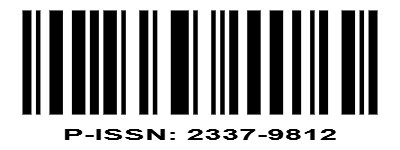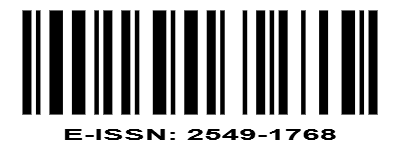EFFICACY TEST OF LIME LEAF ETHANOL EXTRACT (Citrus aurantifolia) AGAINST Aedes aegypti LARVAE
DOI:
https://doi.org/10.22373/biotik.v11i1.16957Keywords:
Aedes aegypti, biolarvacida, Citrus aurantifolia, efficacy test, extractAbstract
The primary carrier of the dengue virus-caused disease dengue hemorrhagic fever is the Aedes aegypti mosquito.By eliminating the flick using larvacides, the effort of seeding can be avoided. Tannin concentration in lime leaf extract (Citrus aurantifolia) is known to suppress the growth of larval cuticles. The objective of the study was to assess how C.aurantifolia lime leaf extract affected the development of Ae. aegypti larvae. This form of research is experimental, and this extract is produced by macerating lime leaves in 90% ethanol before extracting it via evaporation. The study included four groups: aquades used as a negative control for testing on larvae and concentrations of 12.5%, 25%, and 50% lime leaf extract. Testing and observations have been conducted for 24 hours. The findings showed that different concentrations of lime leaf ethanol extract (C. aurantifolia), which is 100% poisonous to Ae. aegypti larvae, can impede its growth. To conclude, biolarvasida can be created by using the lime leaf extract. No morphological modifications were made to the Ae. aegypti larvae used in this investigation.
Downloads
References
Agustina, E., AS. Leksono., ZP. Gama and B. Yanuwiadi. 2021. Analysis of Climatic Variability and Dengue Hemorrhagic Fever Incidence at the Tsunami Area Banda Aceh City. IOP Conference Series: Earth and Environmental Science. 948 012076.
Athaillah, F., R. Ichwani and N. Asmilia .2018. Kepadatan Larva Nyamuk Aedes spp. Sebagai Vektor Demam Berdarah Dengue (DBD) di Daerah Pesisir Alue Naga Kecamatan Syiah Kuala Banda Aceh. JIMVET. 2(4): 488–492.
Meilin, A and RH. Praptana. 2014. Dampak Insektisida Deltametrin Konsentrasi Subletal pada Perilaku dan Biologi Parasitoid. Iptek Tanaman Pangan. 9(2): 78–84.
Agustina, E., W. Sari and A. Ofreza .2019. The Preferred Plant by Aedes in Houseyard of Kopelma Village Banda Aceh. Journal Aspirator of Vector-borne Disease Studies. 11(1): 59–66.
Agustina, E., AS. Leksono., ZP Gama., B. Yanuwiadi and M. Sukma. 2022. Potential of House Yard Plants as an Alternative for Dengue Vector Control in the Tsunami Area Settlement of Banda Aceh City. Journal of Applied Pharmaceutical Science. 12(11):122-137.
Gama, ZP and E. Agustina. 2022. The Dynamics of Environmental Change Pose Challenges to Preserving the Biocultural Landscape in Indonesia. in SA. Abdullah., AS. Leksono dan SK. Hong (Ed). Conserving Biocultural Landscapes in Malaysia and Indonesia for Sustainable Development. Springer. Singapore. Hal: 127-141.
Herlina, T., E. Julaeha., EE. Ernawati., Darwati and M. Nurzaman. 2020. Antioksidan Dari Jeruk Nipis (Citrus aurantifolia) Sebagai Peningkat Imunitas Tubuh Dalam COVID-Jurnal ITEKIMA. 8(2): 19–29.
Putri, SD., A M. Ulfa and Nofita. 2021. Uji Aktivitas Variasi Konsentrasi Larutan Ekstrak Kulit Jeruk Nipis (Citrus aurantifolia) Sebagai Larvasida Aedes aegypti. Journal of Pharmacy and Tropical Issues.1(2): 1–9.
Kasi, PD. 2012. Pemanfaatan Ekstrak Daun Jeruk Nipis (Citrus aurantifolia) Sebagai Insektisida Nabati Terhadap Hama Walang Sangit (Leptocorisa oratorius) pada Tanaman Padi. Jurnal Dinamika. 3(1): 12–18.
Hayana, R., Maharani and IP. Sari. 2020. Uji Efektivitas Ekstrak Daun Jeruk Nipis (Citrus aurantifolia) Dalam Menghambat Pertumbuhan Larva Nyamuk Aedes aegypti. Jurnal Menara Ilmu. 14(2):46–50.
Yulidar dan Isfanda. 2021. Tingkat Kematian Larva Culex quinquefasciatus Homozigot Seleksi Indukan Tunggal Terhadap Insektisida Malation 1 PPM. in Prosiding Seminar Nasional Biotik. 9(1) :333–335.
Akbar, F., Z. Mappau, and FS. 2017. Efektifitas Jeruk Nipis (Citrus Aurantifolia) Dalam Mematikan Larva Nyamuk Anopheles sp.. Jurnal Kesehatan Manarang. 3(2):64–68.
Adrianto, H., S. Yotopranoto and Hamidah. 2014. Efektivitas Ekstrak Daun Jeruk Purut (Citrus hystrix), Jeruk Limau (Citrus amblycarpa), dan Jeruk Bali (Citrus maxima) Terhadap Larva Aedes aegypti. Journal Aspirator of Vector-borne Disease Studies. 6(1): 1–6.
Monica, R and Khomsatun. 2018. Efektivitas Perasan Daun Jeruk Nipis (Citrus aurantifolia) Terhadap Kematian Larva Aedes aegypti Instar III di Laboratorium Loka Litbang P2B2 Ciamis Jawa Barat Tahun 2017. Keslingmas. 37(2): 235–239.
Redo, T., Triwani., C. Anwar and Salni. 2019. Larvicidal Activity of Ketapang Leaf Fraction (Terminalia catappa L) on Aedes aegypti instar III. Macedonian Journal of Medical Sciences. 7(21): 3526–3529,
Kumara, CJ., RS. Nurhayani, RS. Bestari and LM. Dewi. 2021. Efektivitas Flavonoid, Tanin, Saponin dan Alkaloid Terhadap Mortalitas Larva Aedes aegypti. in Iniversity Research Colloqium. 13:106–118.
Nishan, M., P. Subramanian., R. Saahatish and VAS. Jesudoss. 2017. Toxicity of Citrus aurantifolia and Citrus hystrix against Aedes albopictus Larvae. International Journal of Biosciences. 10(6): 48–54.
Clarissa, B., RP. Susilowati., LD. Yen and B. Hartono. 2021. Kajian Efektivitas Insektisida Berbahan Bunga Krisan ( Chrysanthemum cinerariaefolium ) dan Jeruk Nipis ( Citrus aurantifolia ) terhadap Mortalitas Nyamuk. Jurnal Kedokteran MEDITEK. 27(2): 157–163.
Ardianto, H and Hamidah. 2018. Evaluasi Toksisitas Ekstrak Metanol Daun Jeruk Nipis (Citrus aurantifolia) Terhadap Kematian Larva Nyamuk Aedes aegypti. Journal Aspirator of Vector-borne Disease Studies. 10(1): 57–64.
Downloads
Additional Files
Published
Issue
Section
License
Authors who publish with BIOTIK: Jurnal Ilmiah Biologi Teknologi dan Kependidikan agree to the following terms:
- Authors retain copyright and grant the journal right of first publication with the work simultaneously licensed under a Creative Commons Attribution License that allows others to share the work with an acknowledgement of the work's authorship and initial publication in this journal.
- Authors are able to enter into separate, additional contractual arrangements for the non-exclusive distribution of the journal's published version of the work (e.g., post it to an institutional repository or publish it in a book), with an acknowledgement of its initial publication in this journal.
- Authors are permitted and encouraged to post their work online (e.g., in institutional repositories or on their website) prior to and during the submission process, as it can lead to productive exchanges, as well as earlier and greater citation of published work.











